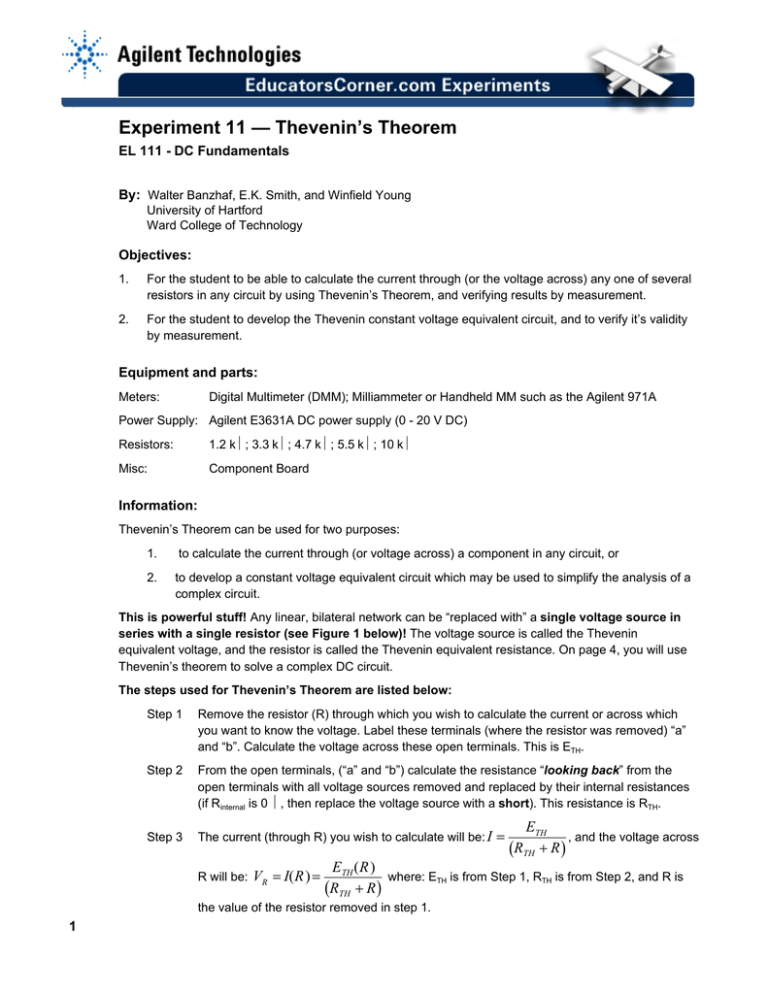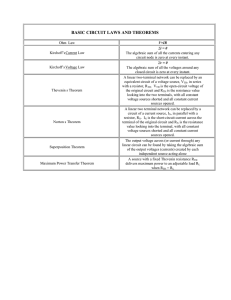Experiment 11 — Thevenin`s Theorem
advertisement

Experiment 11 — Thevenin’s Theorem EL 111 - DC Fundamentals By: Walter Banzhaf, E.K. Smith, and Winfield Young University of Hartford Ward College of Technology Objectives: 1. For the student to be able to calculate the current through (or the voltage across) any one of several resistors in any circuit by using Thevenin’s Theorem, and verifying results by measurement. 2. For the student to develop the Thevenin constant voltage equivalent circuit, and to verify it’s validity by measurement. Equipment and parts: Meters: Digital Multimeter (DMM); Milliammeter or Handheld MM such as the Agilent 971A Power Supply: Agilent E3631A DC power supply (0 - 20 V DC) Resistors: 1.2 kΩ; 3.3 kΩ; 4.7 kΩ; 5.5 kΩ; 10 kΩ Misc: Component Board Information: Thevenin’s Theorem can be used for two purposes: 1. to calculate the current through (or voltage across) a component in any circuit, or 2. to develop a constant voltage equivalent circuit which may be used to simplify the analysis of a complex circuit. This is powerful stuff! Any linear, bilateral network can be “replaced with” a single voltage source in series with a single resistor (see Figure 1 below)! The voltage source is called the Thevenin equivalent voltage, and the resistor is called the Thevenin equivalent resistance. On page 4, you will use Thevenin’s theorem to solve a complex DC circuit. The steps used for Thevenin’s Theorem are listed below: Step 1 Remove the resistor (R) through which you wish to calculate the current or across which you want to know the voltage. Label these terminals (where the resistor was removed) “a” and “b”. Calculate the voltage across these open terminals. This is ETH. Step 2 From the open terminals, (“a” and “b”) calculate the resistance “looking back” from the open terminals with all voltage sources removed and replaced by their internal resistances (if Rinternal is 0 Ω, then replace the voltage source with a short). This resistance is RTH. Step 3 The current (through R) you wish to calculate will be: I R will be: VR = I( R ) = ETH , and the voltage across (RTH + R ) ETH ( R ) where: ETH is from Step 1, RTH is from Step 2, and R is (RTH + R ) the value of the resistor removed in step 1. 1 = The constant voltage equivalent circuit is developed from the values calculated in the above steps. See Figure 1 below: Procedure: 1. The purpose of this procedure is for the student to practice the procedural steps of Thevenin’s Theorem and compare the resultant calculations with measured values. Thevenin’s Theorem will be used to find the current through R3. a) Connect the circuit in Figure 2. b) Measure the current through R3 and the voltage across R3. Record them: IR3 = (meas) ER3 = (meas) c) Use Thevenin’s Theorem to calculate the current through R3, by following the steps outlined on page one. SHOW ALL WORK in space provided. Record the results for each step in the space provided. Step 1: Refer to Figure 3, which is Figure 2 with R3 removed. Calculate ETH in Figure 3, showing all work. ETH = 2 (calc) d) Verify Step 1 by measurement: Connect Figure 3, and measure and record ETH. ETH = (meas) e) Step 2: Refer to Figure 4, which is Figure 2 with R3 removed and the 24 V source replaced by a short circuit (a dead voltage source). Calculate RTH in Figure 4, showing all work. RTH = f) (calc) Verify Step 2 by measurement: Connect Figure 4, and measure and record RTH. RTH = (meas) g) Draw below the Thevenin equivalent circuit, using your calculated values for ETH and RTH. This diagram is Figure 5. 3 h) Step 3: Calculate IR3 using the Thevenin equivalent circuit (the ETH and RTH you found above). I= ETH (RTH + R ) i) Compare the current measured in step 1.b (original circuit) and the current calculated in step 3 above (which used Thevenin’s Theorem). If they are not reasonably close, find the reason for the discrepancy). j) Build the circuit of Figure 5. Obtain a resistor for RTH as close as possible to its calculated value (or use a potentiometer, whose value you can set equal to RTH. k) Measure the current through R3 and the voltage across R3 in the circuit of Figure 5. Record them: IR3 = l) 2. (calc) ER3 = (calc) Compare the measured results of part k) above (using the Thevenin equivalent circuit) with the measured results of part b) (the original circuit). If the results are not close, find the reason for the discrepancy. Use Thevenin’s Theorem to find the current through R3 in the bridge circuit of Figure 6. Use measured resistor values in all calculations below. a) Do all the Thevenin’s Theorem steps showing all calculations and diagrams, properly labeled, on a separate sheet of paper. 4 Step 1: Solve for ETH. ETH = (calc) Step 2: Solve for RTH. RTH = (calc) Step 3: Calculate IR3 using the Thevenin equivalent circuit (the ETH and RTH you found above). IR 3 = ETH ( RTH + R3 ) IR3 = (calc) b) Draw below the Thevenin equivalent circuit, including R3. c) Connect the original circuit in Figure 6 (with all five resistors). d) Measure the current through R3. IR3 = (meas) e) If measured and calculated currents through R3 are not close, find the reason for the discrepancy. 5




